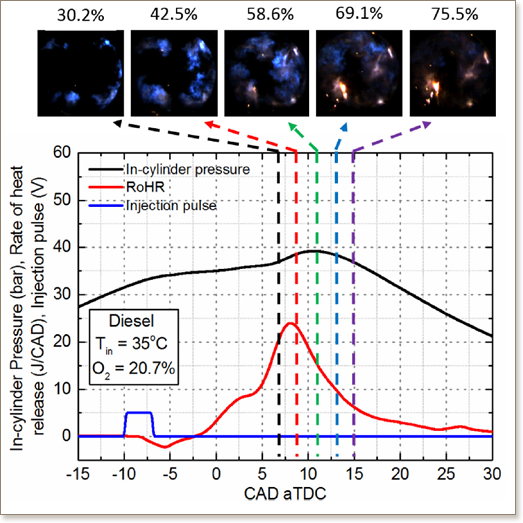Combustion Stratification for Naphtha from CI Combustion to PPC
R. Vallinayagam, S. Vedharaj, Y. An, A. Dawood, M. Najafabadi, B. Somers, B.H. Johansson

This study demonstrates the combustion stratification from conventional compression ignition (CI) combustion to partially premixed combustion (PPC). Experiments are performed in an optical CI engine at a speed of 1200 rpm for diesel and naphtha (RON = 46). The motored pressure at TDC is maintained at 35 bar and fuelMEP is kept constant at 5.1 bar to account for the difference in fuel properties between naphtha and diesel. Single injection strategy is employed and the fuel is injected at a pressure of 800 bar. Photron FASTCAM SA4 that captures in-cylinder combustion at the rate of 10000 frames per second is employed. The captured high speed video is processed to study the combustion homogeneity based on an algorithm reported in previous studies. Starting from late fuel injection timings, combustion stratification is investigated by advancing the fuel injection timings. For late start of injection (SOI), a direct link between SOI and combustion phasing is noticed. At early SOI, combustion phasing depends on both intake air temperature and SOI. In order to match the combustion phasing (CA50) of diesel, the intake air temperature is increased to 90°C for naphtha. The combustion stratification from CI to PPC is also investigated for various level of dilution by displacing oxygen with nitrogen in the intake. The start of combustion (SOC) was delayed with the increase in dilution and to compensate for this, the intake air temperature is increased. The mixture homogeneity is enhanced for higher dilution due to longer ignition delay. The results show that high speed image is initially blue and then turned yellow, indicating soot formation and oxidation. The luminosity of combustion images decreases with early SOI and increased dilution. The images are processed to generate the level of stratification based on the image intensity. The level of stratification is same for diesel and naphtha at various SOI. When O2 concentration in the intake is decreased to 17.7% and 14.7%, stratification level is decreased. NOX emission for both diesel and naphtha show a decreasing trend from CI to PPC. Comparing diesel and naphtha, the soot emission is lower for naphtha. NOX and soot emissions at various SOI are correlated with high speed images of combustion to explain the combustion stratification.